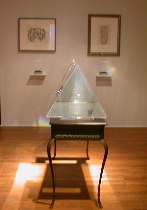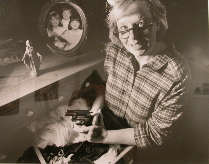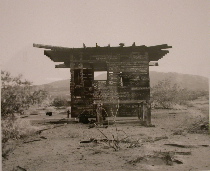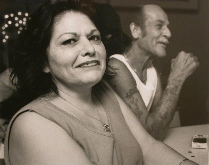
Japanese-born artist Keiko Miyamori falls into the category of tree hugger. Surprisingly, she’s also an archivist. The Philadelphia artist hugged a tree stump, root and all, in a piece at Project Room a few years back. The project, called “Imagina,” showed the big stump and huge root system and archived the junk the artist found trapped in the tree’s roots (everything from a mound of bricks to coke bottles to shards of metal, glass, wood and plastic).
The entire project was Paul Bunyanesque with a twist of Charles Wilson Peale’s natural history museum thrown in.
Miyamori‘s new piece in the Nexus Community Gallery (upstairs behind Highwire) is still about trees (no roots this time) but it continues the artist’s ongoing themes of harmony in the world, here merged with some musical underpinnings — the music of the spheres in the peaceable kingdom. (image top is “Memoria” at Nexus)
The centerpiece of the museum-like installation is a large, glass prism sitting on a table and casting little rainbows here and there around the room. On the walls are gilt-framed drawings labelled “Chestnut Hill, West Philadelphia,” etc. Small shelves hold altered and numbered harmonicas; and two piano keyboards stick out from two walls. The drawings, beautiful and abstract, are charcoal rubbings of tree bark in the various neighborhoods.
The harmonicas, their tops and bottoms adorned with paper-and-ink drawings that fit like new skin, are elegant whatizits sitting on black velvet perches on top of what looks like hand-made boxes. There’s a kind of innocence and modesty here that makes the whole thing rise above the seemingly corny prism and rainbows. (detail of rainbow and harmonica, left)
Photo-realism downstairs
Downstairs at Nexus the new members’ show is a mixed bag. Of the five debutantes, photographers Jenny Drumgoole and James Wasserman had the most nuanced and affecting work.

Drumgoole’s gelatin silver prints present her family and friends, warts and all, in shots rich with rural or small-town America weirdness. There is mom, curlers in her hair showing off her anniversary gift, a gun. There is dad, posing in the basement in front of his home brewery. (image, above is mom with her gun)
The work has a kind and gentle edge. These works don’t mock, but they do have an ohmygosh lookatthiswillya attitude that feels about right for the subject.
James Wasserman’s black and white photographs of decaying shacks in Wonder Valley California reminded me of some of Lewis Baltz’s photographs I saw last year at Princeton University Art Museum. The portraits of decaying shacks in the middle of wide open, desolate spaces were organized into poignant triptychs. The shots were full of crisp detail and the whole thing was loneliness personified. 
Even better were Wasserman’s portraits of the inhabitants of Wonder Valley which reminded me of Mary Ellen Mark in their intimacy and subtlety. (image above is one of the shacks; image, right is “Darlene and Bill”)
Others in the show include Susan Abrams, Anne Cecil and Virginia Batson.









